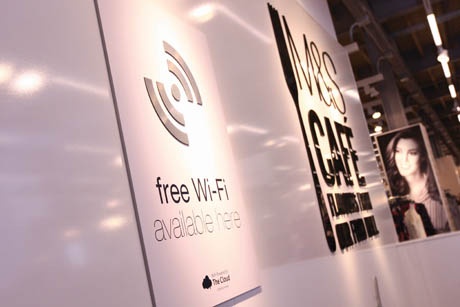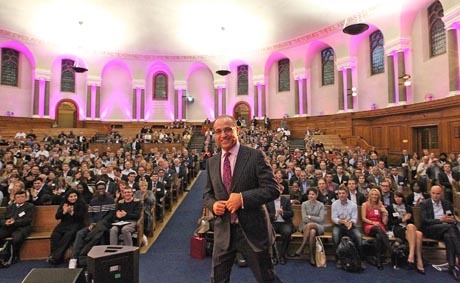The click moment
If success is random, as the author of The Click Moment claims, can anything be systematically done to create it? In truth, a combination of the right kind of people, outstanding ideas and measured risk will form the cornerstone of a successful business.

It’s every company’s dream to come up with a product or idea that changes everything but few are lucky enough to succeed in doing it. There are some organisations, however, that make it look easy - Apple has done so repeatedly, with innovations such as the iPod, iTunes, iPhone and iPad all altering the landscape of their respective markets.
The secret to coming up with new, game‑changing ideas is something every brand, and every marketer, wants to learn.
But according to a new book, The Click Moment: Seizing Opportunity in an Unpredictable World, by Frans Johansson, there is no way to know how or when these seminal ideas will come about and whether they will be successful when they do. They are influenced by so many unpredictable and complex factors that they are effectively random, and neither experience nor training are of any help.
A chain of events
The most significant successes of companies such as Starbucks, Microsoft and Google could not have occurred if not for certain events outside their founders’ control, Johansson claims.
He tells Marketing Week: “If you dig deep underneath any success story, it tends to be very polished and put together after the fact.
“While it was happening, nobody could really have foreseen it. Even stories that we know very well are just a way of providing a pattern - an explanation for what happened.”
He gives the example of Howard Schultz, chief executive at Starbucks. Schultz only hit upon the idea of selling a coffee-shop experience - as opposed to just the beans - after trying espresso for the first time in a Milan coffee bar.
Yet the randomness of such ‘click’ moments doesn’t mean you can’t increase the chance of one occurring, Johansson argues. “This may surprise some people, because if you say that success is entirely random, the implication is that there is nothing you can do to drive it. That’s not true because you can dramatically increase the amount of serendipity [happy accidents] in your life.”
Chance encounters
Stories abound of chance encounters that have been the genesis of an entire business. Bulldog Natural Skincare co-founder Simon Duffy had the idea to launch a brand of men’s grooming products derived from natural ingredients when he realised the dearth of options available on the shelves of a New York Whole Foods Market store (see Q&A, below).
Duffy believes that although the click moment he experienced came about by chance, they are more likely to happen to someone who is already equipped with good ideas. For example, he already had the ambition to develop organic and health-driven products of some kind before the crucial moment when he saw the marketing opportunity in men’s grooming.
You also need to be open to new experiences, he argues. “There are probably a few factors that make up the right individual. The personality needs to be curious. You have also got to furnish yourself with knowledge. You can help generate good ideas by reading widely, keeping your eyes open for new things, talking to people and trying to get out of your comfort zone.”

Bulldog: relies on in-house ideas and opinions instead of focus groups
But Duffy says this is different from generating big ideas through a logical and repeatable approach. He says Bulldog carries out little market research because the company prefers its products to feel intuitive and believes its employees are the best judges of quality.
“Can you control it? Can you bottle the lightning? I think that is what the biggest companies in the world are always systematically trying to do - trying to come up with systems and processes and rationality for innovation. I don’t think that is actually a very effective path,” Duffy says.
Unpredictable innovation
In The Click Moment, Johansson suggests that approaching business through a logical and analytical assessment of the marketplace is the antithesis of how big, successful ideas come about. He argues that the analytical approach is a way of understanding how best to play by the rules as they stand, when the real challenge is to come up with an unpredictable innovation that moves the goalposts entirely.
This is the challenge Apple took on when it launched the iPhone in 2007. Rival mobile phone manufacturer Nokia was taken by surprise and eventually found itself unable to compete. As Nokia vice-president and global head of marketing creation Steven Overman admitted at the Marketing Week Live event in June, Nokia took too long to adapt its business to focus on smartphones, even though the competitive advantages of its old ways of thinking had evaporated.
“We realised that the very things that made us such a winner had become the very things that held us back. A complete personality change was in order and that is what Nokia is in the process of doing today,” Overman says.
The iPhone hasn’t been the only Apple product to change an industry. The company has done the same with the iPod and iPad, suggesting it has found a way to come up with market-defining innovations on a regular basis.
But this hasn’t been down to market research or pursuing incremental growth, according to an unnamed Apple employee quoted by Johansson. Instead, a key aspect of Apple’s success is that every innovative idea is chosen as the best of around 10 being developed concurrently. The public never sees Apple’s failed innovations.
Customer research

Apple’s repeated successes are only the visible part of a huge innovative programme
Other companies need to test their new ideas with customers to know whether they will work. Retailer Marks & Spencer is currently taking this approach to testing out new in-store digital technology as it seeks to transform itself into a single multichannel operation. It no longer seeks to make a distinction between its online and bricks-and-mortar businesses but counts its ‘bricks-and-clicks’ sales together (see case study, below).
M&S executive director of multichannel ecommerce Laura Wade-Gery sums up the company’s task: “How do we use technology and particularly the internet, almost to reinvent store shopping? It is as big an ambition as that. If we are going to plan a successful multichannel business, that is what we’ve got to do.
“Many retailers operate a series of parallel universes - an online business and a store business. What we are trying to do is bring together the best of both.”
Rapid failure
M&S is trying to achieve this reinvention of retailing by rolling out systems including touchscreens, where shoppers can buy electronically in-store, as well as iPads carried by shop assistants that can show customers the full range of products.
Testing, of course, entails the possibility of failure but, according to Wade-Gery, this is an acceptable risk built into the M&S strategy - the proviso being that if individual ideas fail, they must do so quickly and cheaply.
“One of the ways that I can judge whether we are getting successfully on to that journey to being a multichannel retailer is quite simply the rate at which we are innovating and changing,” she says.
The concept of ‘failing fast’, familiar to many technology firms, bears similarities to Johansson’s advice for creating click moments. He says companies should be prolific in backing new ideas but also minimise the size of each bet and take the smallest step that will give a meaningful indication of success or failure.
He also argues that companies need to change their attitude towards the risks of failing, calculating what they can afford to lose, rather than the return they expect on each new investment. Otherwise, he says, the business culture will always be directed towards safe incremental growth and not game‑changing innovations.
Research the market
While many of the businesses and entrepreneurs Marketing Week has spoken to agree that creativity needs to be freed from conventional logic, they disagree with Johansson on some key points. First among these is the ability to predict whether demand for an idea exists.
According to Theo Paphitis, one of the ‘dragons’ from BBC Two TV show Dragons’ Den, researching the market remains an important way “to make sure the odds are stacked in your favour” (see case study, right).
Bulldog’s Duffy points out that discovering a gap in the market is one thing, “but then you’ve got to work out if there’s a market in the gap”.
Most new ventures - particularly those of start-up companies - won’t secure the investment to get off the ground without showing that the demand exists to sustain a successful business. And many entrepreneurs only get one shot to turn an idea into a reality.

Travel firm Black Tomato focuses on the experience, rather than the destination
Tom Marchant, co-founder of travel company Black Tomato, says that “huge data gathering” went into understanding that there was a future for his business idea. The start-up firm, begun from a bedroom in Putney in 2005, sells bespoke tours that focus on an experience before determining the destination, rather than the other way round. The evaluation of the market took place while the three founders were still working full-time in other jobs.
“We had to start understanding from the people we were working with at different companies - colleagues or clients - what the appetite would be for what we wanted Black Tomato to be. There were a number of colleagues and friends who had come back from holiday and were hugely underwhelmed by their experiences.”
Gut instinct
Part of identifying the marketing opportunity was “gut instinct”, says Marchant. “But at the same time, we wanted to be confident that what we felt from the gut and what we picked up on our travels actually held true. We applied a little bit of rigour and formality to confirming that and it gave us a very clear idea of what we wanted Black Tomato to be.”
Again, unlike Johansson, Marchant is firmly of the opinion that the temperament of the individual is the most important factor in predicting the likelihood of a click moment occurring. He admits that the business idea for Black Tomato might not have been realised if it hadn’t been for the chance meeting with one of the company’s other founders, Matt Smith, while travelling in Australia but he is certain that they would each have launched their own ventures even if they had never met.
He echoes Dragons’ Den star Paphitis, who says being the right kind of person is more important to success than having an outstanding idea.
But Marchant is in agreement with Johansson’s advice in The Click Moment on one other point: passion must be used as a fuel to drive forward a successful idea. Even if the opportunity exists, a business won’t be able to take advantage of it unless those behind it have the belief to take it into the market and defy the established conventions.
“The one thing that we did believe in strongly was that working on something that is a passion of yours shouldn’t be seen as a bad thing, despite people saying that turning a hobby into a job is a good way of killing the passion for it. We saw it, and still see it, very differently,” says Marchant.
“If you’re hugely enthused by an area, then the motivation to do well and immerse yourself in it is stronger.”
Viewpoint

Frans Johansson
Author, The Click Moment
It is not a fluke that Andy Murray is good at tennis. It requires massive commitment and massive practice. But if you look at Sir Richard Branson, he didn’t need airline experience to make Virgin Atlantic a success. Why is it that we can predict the success of somebody like Murray, but not of somebody like Branson?
The reason is that the rules of tennis don’t change. Everywhere else, the rules are up for grabs, and the rules change faster and faster. Nokia had the rules of the mobile phone industry down cold – it was the number one brand in Europe in 2006. Mobiles were supposed to have cool colours, cool shapes and cool ringtones.
Within a year the rules of the mobile world had changed with the iPhone. Now, all of a sudden, all phones need to be black, they need to be rectangular with rounded corners, and it isn’t about ringtones, it’s about apps. There was no way of Nokia foreseeing this.
The approach that says I can use logic to work out the next move is not helpful. If it is logical, then everybody is going to do it. The value in playing with a logical approach is being diminished rapidly. The faster industry is changing, the faster the value is disappearing.
So if success is so random, what do you do about it? It’s about stepping away from the logical path. You can start by taking your eyes off the ball. When we plan, we don’t leave room for serendipity. Allow yourself scheduled room, incorporate space to allow serendipity to happen.
You can’t dramatically up your chances of success by making any given bet. You have to place many bets. Picasso made 50,000 works of art in his lifetime and what we forget is that not every one is a masterpiece. Many of them completely suck, but that’s ok.
If each bet is very expensive, you can’t try many attempts, so you have to decrease the cost of the bet. I’m not just talking about money, it’s also about time and resources.
The number of options available to marketers today have exploded. If an agency has one really successful campaign, we assume they’ve got it figured out. But do they? What I am telling people is, assume you don’t know, and this is going to guide your actions.
Q&A

Simon Duffy
Founder
Bulldog Natural Skincare
Marketing Week (MW): How did the idea for the Bulldog Natural Skincare brand come about?
Simon Duffy (SD): If there was such thing as a lightbulb moment, it was going through a Whole Foods store in New York City, which is full of brands that are about health and wellness. I was looking for a particular product for my wife and I thought I would pick up some products for myself while I was there, but there were only two products for men out of a category of maybe 500 in the store.
That was the point when I thought, wow, there’s a gap in the market. I hadn’t thought previously about going into grooming but I had previously identified natural and organic, health and wellness as the organising themes and that I wanted to go into that space. I wanted to provide a healthier or fresher or more natural alternative to what people had.
MW: How do you think these kinds of moments come about? Can you make them happen?
SD: I think it always takes a visionary or an innovator, or someone with the right kind of personality. If we had done a focus group and said the brand is named after a dog and the products are all natural, no-one would have come up with the idea. Having something quirky or unique has more chance of standing the test of time than something that comes out of the focus group approach, which feels generic and commoditised and the same as what came before.
We are still in the phase where we are designing new products for ourselves and we treat ourselves as the best judge of the way the brand should go forward – whether that is the consistency of a face-wash, the fragrance of a shower gel or the packaging. All these things that might be modelled and quantified and tested, we are not doing. That’s a function of having a small budget and we would much rather be spending our money on activation than research but we also prefer to be connected with an idea that still feels quite intuitive.
MW: Is it acceptable to try an idea and fail, if that process leads on to better ideas?
SD: The rate of failure of new product launches is something like 90 per cent. It is different for different companies but when we started the acceptable rate of failure was 0 per cent – it had to work. For someone in our position, we only had one chance. There is probably an accepted tolerance or risk at some of the bigger companies and that is why these failures come through.
What a lot of entrepreneurs try to do is rush to market first. What we learned is that our initial concept didn’t have to be the final product. We kept improving it, but the biggest gain for me was in the way we connected with consumers. We went through three different versions of our packaging. Operationally it was complicated but with each innovation we got better until we got to where we are now, where we feel comfortable both with the product and with the story we are telling.
Marks & Spencer: ‘Fail fast’

M&S: providing iPads on which customers can shop to avoid the tills
In its efforts to become a multichannel retailer, Marks & Spencer has adopted a ‘fail fast’ approach to technological innovations – a principle common to many digital firms. According to this philosophy, the small amount of resources devoted to developing less fruitful projects will be dwarfed by the gains when a big, successful idea eventually clicks.
As part of its multichannel strategy, M&S is rolling out interactive digital screens and iPads into its stores, from which shoppers can browse, buy or order without going to a checkout. M&S has announced a £100 million investment in new in-store technologies, in addition to the £150 million it will spend on overhauling its website.
In September, Marketing Week attended the opening of a new M&S store at Cheshire Oaks near Chester, which now serves as the flagship site for demonstrating its in-store digital systems. M&S executive director of multichannel e-commerce Laura Wade-Gery explains that the retailer needs to test various new ideas at a rapid rate in order for the strategy to succeed.
“In an online and multichannel business, the faster you can get things to market and test them – ‘fail fast’ would be the jargon – the more you learn about what works for customers in practice.”
But some elements of M&S’s new technology will be harder to test quickly and cheaply than others. For example, stores have begun installing what Wade-Gery calls “digital inspiration screens”, which each each cost around £8,000.
M&S is also introducing 36-inch interactive touchscreen shopping systems that have been commissioned from specialist hardware provider Wincor Nixdorf. They are “future-proofed”, Wade-Gery says, to allow for the installation of contactless payment technologies such as RFID and NFC, as well as chip-and-pin.
Though Wade-Gery does not state the value of these screens, they are likely to be more expensive than the non-interactive screens. And the fact that they are bespoke designs with the in-built capacity for further adaptation suggests that M&S is likely to gamble a significant portion of its investment in this area. The question – if these innovations do fail to push up sales – is whether they will fail quickly or cheaply enough.
When Marketing Week tested the browsing systems at Cheshire Oaks, load times for product pages were slow, and additionally the requirement to enter an email address before purchasing could deter customers from completing transactions. Attempting to connect to the in-store Wi-Fi signal via a smartphone also proved unsuccessful.
It is possible these were isolated experiences and each could also be easily improved if necessary. But the concept of in-store digital ordering itself is one that M&S will probably need to commit to whole-heartedly – and in that case it can’t afford for it to fail.
Theo Paphitis

Best known for his role in BBC Two TV show Dragons’ Den, where budding entrepreneurs pitch for investment, Theo Paphitis has encountered more new business ideas than most businessmen will in an entire career.
Speaking at an event hosted by the Evening Standard newspaper, Paphitis pointed out that half of all small businesses fail in their first two years. But he takes an opposing view to that of Frans Johansson’s book, The Click Moment. Where Johansson claims success or failure is based on circumstances too complex to predict, Paphitis believes researching the market ahead of launch is the main determining factor.
“You need to make sure the odds are stacked in your favour. If you do that in a casino, it’s called cheating, but if you do it in business, it’s just doing your homework.”
In fact, in its influence over the eventual outcomes, the business idea itself ranks below the personalities of the people involved, in Paphitis’s view. He says the person behind the business is more likely to be the aspect of a new pitch that will convince him to invest, and adds too that some entrepreneurs with outstanding concepts fail because they “can’t get out of bed in the morning”.
“A person who is not right, with a great idea, has got a better chance of failing than someone who you think can do something, but with an average idea,” Paphitis argues.
Paphitis has also become a specialist at buying out troubled businesses with a view to turning them around. In July he added the £10 million purchase of high street hardware retailer Robert Dyas to his portfolio, which includes start-up lingerie retailer Boux Avenue.
Paphitis says that turning a business around requires the same understanding of the market as investing in a new one, because “not all businesses can be turned around”. He has similar advice to that of Johansson for businesses that have been rendered uncompetitive by disruptive innovations in their marketplace.
In this case, a company that carries on as it always has, or that tries simply to emulate its more successful competitors, is not likely to save itself, he argues. “Some businesses don’t have a reason to exist any more. They’ve got to recognise it and change.”
But unlike Johansson, Paphitis suggests that it is unwise for a business to structure itself around the assumption that it can come up with a single big idea to cure all its ailments. “It is never one thing that makes a business successful. It is a combination of things. It is never one thing that makes a business fail.” He adds: “If you’ve got problems in your business, don’t look for a silver bullet. It’s unlikely to be there.”









